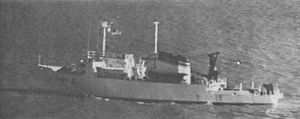USNS James M. Gilliss (T-AGOR-4)
 USNS James M. Gilliss (AGOR-4) on 14 December 1962 | |
| Career (USA) | |
|---|---|
| Name: | USNS James M. Gilliss |
| Namesake: | James Melville Gilliss, born 6 September 1811 in the District of Columbia |
| Builder: | Christy Corp, Sturgeon Bay, Wisconsin |
| Laid down: | 31 May 1961 |
| Launched: | 19 May 1961 |
| Sponsored by: | Mrs. Hubert H. Humphrey, wife of the Senator from Minnesota |
| Acquired: | by the U.S. Navy, 5 October 1962 |
| In service: | 5 November 1962 as USNS James M. Gilliss (T-AGOR-4) |
| Out of service: | date unknown |
| Struck: | date unknown |
| Fate: | transferred to the Mexican Navy, as Altair (H-05) |
| Notes: | operated at an oceanographic ship by Mexico |
| General characteristics | |
| Type: | Robert D. Conrad-class oceanographic research ship |
| Tonnage: | 1,200 tons |
| Tons burthen: | 1,370 tons |
| Length: | 209' |
| Beam: | 40' |
| Draft: | 16' |
| Propulsion: | diesel-electric, single propeller, 2,500shp, retractable azimuth-compensating bow thruster |
| Speed: | 12 knots |
| Complement: | 23 civilian mariners, 38 scientists |
| Armament: | none |
USNS James M. Gilliss (T-AGOR-4) was a Robert D. Conrad-class oceanographic research ship acquired by the U.S. Navy in 1962. She performed various underwater surveys and tests in the Atlantic Ocean and eventually was transferred to the Mexican Navy as an oceanographic research ship in 1996.
Contents
Built in Sturgeon Bay, Wisconsin
The second ship to be so named by the Navy, James M. Gilliss (T-AGOR-4) was laid down by Christy Corp., Sturgeon Bay, Wisconsin, 31 May 1961; launched 19 May 1962; sponsored by Mrs. Hubert H. Humphrey, wife of the Senator from Minnesota; delivered to the Navy 5 October 1962; and turned over to the Military Sea Transportation Service (MSTS) 5 November 1962, Captain Torston Johnson in command.
Oceanographic service
Manned by a civilian crew and carrying 15 scientists from the Naval Oceanographic Office, James M. Gilliss was the first of a new class of oceanographic ships to be operated by the Military Sea Transportation Service (MSTS). In addition to the latest in oceanographic and meteorological equipment, she also possessed unusual design features, including special antiroll tanks for stability and a retractable bow propulsion propeller. As a mobile, floating research laboratory, she was capable of carrying out experiments in sound transmission, underwater life, and ocean floor characteristics, thus enabling her to help continue the Navy's lead in the exploration and understanding of "inner space."
Searching for Thresher
Departing Sturgeon Bay 8 November, she arrived New York City 19 November for sea trials and shakedown. On 12 April 1963 she departed New York City to take part in the massive search for sunken submarine Thresher (SSN-593). Operating out of Boston, Massachusetts, she lent her "know-how" to this vital and difficult operation for 5 months before arriving Washington, D.C., 22 September. After returning to New London, Connecticut, for additional equipment tests, she departed 1 November for oceanographic research operations off Bermuda.
North Atlantic operations
During the next 4 months she operated in the Atlantic from the Bahamas to the New England coast. In March 1964 she steamed to the Caribbean for surveying and scientific work out of San Juan, Puerto Rico. Arriving Key West, Florida, 28 March, she operated from the Strait of Florida to the Bahamas and Bermuda for more than a year.
Departing Key West 23 May 1965, she arrived New York 27 May and prepared for deployment to waters off the British Isles. She sailed 14 June; arrived Belfast, Northern Ireland, 27 June; and began 3 months of research and survey operations from the British Isles and France to Newfoundland.
Departing Belfast 15 September, she returned to New London 6 October and resumed research operations off the U.S. East Coast, which have continued into 1967. She continued to operate in the Atlantic from New England to the Bahamas while supporting important surveys and scientific experiments of the Naval Oceanographic Office.
Post-mission inactivation
James M. Gilliss was placed out of service on an unspecified date and transferred to the Mexican Navy on 9 December 1996 where she continued to operate for that nation as an oceanographic research ship.
See also
References
- This article includes text from the public domain Dictionary of American Naval Fighting Ships. The entry can be found here.
- NavSource Online: Service Ship Photo Archive - T-AGOR-4 James M. Gilliss
| ||||||||
